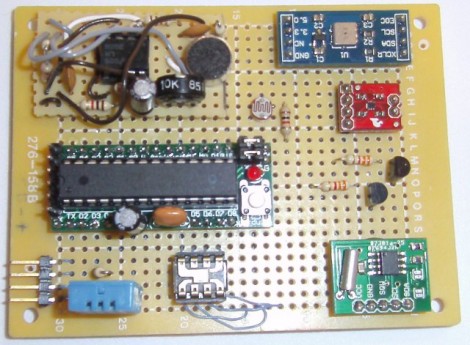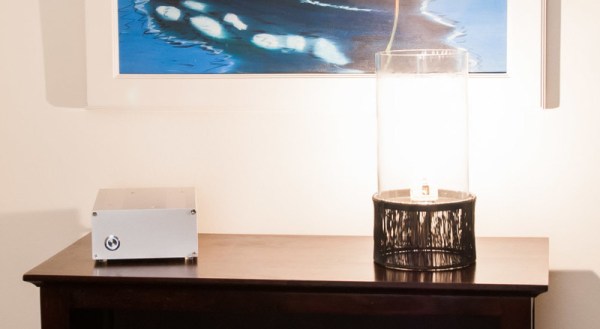The Homestake Mine started yielding gold in 1876. If you had asked George Hearst, the operator at the time, if the mine would someday yield the secrets of the universe I bet he would have laughed you out of the room. But sure enough, by 1960 a laboratory deep in the mine started doing just that. Many experiments have been conducted there in the five and a half decades since. The Large Underground Xenon (LUX) experiment is one of them, and has been running is what is now called the Sanford Underground Research Facility (SURF) for about four years. LUX’s first round of data was collected in 2013, with the experiment and the rest of the data slated to conclude in 2016. The method, hardware, and results wrapped up in LUX are utterly fascinating.
lux4 Articles
DIY Lamps Brighten Winter Blues
As you know, winter is coming. For a lot of people this means that Seasonal Affective Disorder is beginning to set in. [Luke]’s mom already has a light therapy box. It’s one of those commercially available ones that uses fluorescent bulbs and leaves a lot to be desired in the full-spectrum light simulation department. [Luke] jumped on the opportunity to design a better one.
The standard of quality for light therapy units is a rating of 10,000 lux. While lux definitely matters, the rating is a misleading selling point when given on its own. One of the other important factors in mimicking the sun is the Color Rendering Index (CRI). CRI is basically a rating of the bulb’s ability to imitate the color reproduction of natural daylight. The ratings run from 0 to 100 but in reality, the highest-rated bulbs of any kind top out around 98.
For all the fluorescent bulb-bearing light therapy units out there, those bulbs have pretty low CRI ratings. [Luke]’s project page provides emission spectra graphs for a number of bulb types, and we can see how his choice of ceramic metal halide bulbs stacks up against fluorescent, incandescent, and LED bulbs. One of the few downsides to this type of bulb is that they have long startup times.
He ended up making two light therapy lamps, one of them directional and the other omni-directional. They both use ballast-controlled ceramic metal halide bulbs. The ballasts are necessary to provide the high starting voltage that these bulbs require. The omni-directional light is built into a large hurricane candle holder. A lamp holder is fixed into the base and wired to an external ballast box. The directional lamp is a self-contained unit, and [Luke] is happiest with this one. It’s flat and rugged so it can be placed on top of a bookcase and the light bounced off of the ceiling for pleasant, indirect coverage.
We’ve seen a couple of alarm-clock wakeup light builds here, and we’re thinking this would make an awesome mashup.
Lux: A 100% Open Source Camera

[Kevin Kadooka] recently finished his open source camera. The Lux Camera is 100% open source. Lux uses no parts from other cameras – not even a lens! To date we’ve only seen this with achieved with pinhole cameras. [Kevin] isn’t new to camera hacking. He was the man behind the Duo camera, which had a successful Kickstarter campaign in February of 2013. Duo is a DIY camera, but it still required lenses from Mamiya-Sekor, and a shutter from Seiko. Lux is a different animal. It has a manual focus 65mm f/5.6 Single Element lens. The shutter is [Kevin’s] own solenoid based leaf shutter design. Just as in the original shutter, an Arduino controls shutter operation and timing.
The main camera body and many of its parts are 3D printed. [Kevin] got some very nice quality parts from Shapeways 3D printing service. We have to say that some of the assemblies look a bit complex for desktop printers. However since everything is open source, anyone willing to put the time in could adapt them for the average RepRap or Ultimaker. [Kevin] has posted detailed build photos, as well as some photos taken with the Lux on his flickr stream. The pictures have a decidedly holga-esque look to them, due in part to the single element lens. Even with this limitation, we love the idea of having a brownie style camera built completely from scratch.
Sensor Array Tries To Outdo The Other Guys

The team over at the Louisville Hackerspace LVL1 is not going to be outdone when it comes to collecting environmental data. They put together this Frankenstein of sensor boards that lets you collect a heap of data showing what is going on around it.
At the center-left a small Arduino clone is responsible for collecting the data. Data storage is not talked about on their write-up, but if that’s an ATmega328 chip you should be able to work out an easy way to store data on the 1k of internal EEPROM. If that’s not enough, there is an I2C bus included on the board making it easy to add a compatible EEPROM.
The sensor on the bottom left should look familiar. It’s a DHT11 temperature and humidity sensor we’ve seen popping up in projects lately. But wait, there’s also a TMP102 temperature sensor; but that’s not the end of it. A BMP085 pressure sensor also includes a third temperature sensing option. Want to see when the lights go on in the room? There’s a CdS sensor and a TSL230R Lux sensor for that. An op-amp circuit can measure the sound level in the room via one of the Arduino’s ADC pins. And finally, an RTC board is used for time stamping the data.
Obviously this is overkill, and we’re sure it’s meant as a test platform for various sensors. All of them have been mounted on the protoboard and wired up using the point-to-point soldering method.











